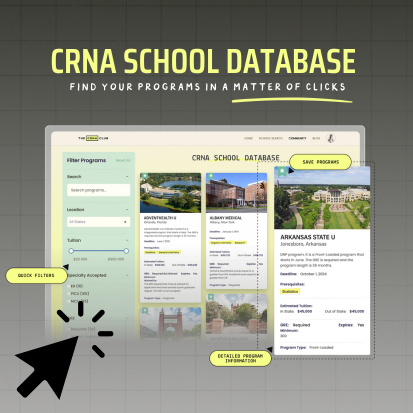I didn’t come from a cardiac nursing background. I’ll take a crani or trauma any day, but cardiac has always been daunting. Don’t let your nursing background pigeonhole you into not believing you can have a great cardiac rotation. It’s challenging and amazing at the same time. In this blog I will present practical tips that I found helpful in having a successful cardiac rotation.
Getting Started: How to Prepare for Your Cardiac Rotation
I can’t say this enough. Review, review, review. If you need to watch YouTube videos, draw visuals, or carry flashcards, do it. Cardiac CRNAs are very knowledgeable and will teach you fantastic hemodynamic manipulating sorcery. However, you will easily be dismissed or regarded as unprepared if you cannot answer basic questions.
Cardiac Basics Every SRNA Should Review:
Review Cardiac Anatomy and Physiology:
Enhance your knowledge of coronary circulation, cardiac output, valve functions, and electrophysiology to better interpret patient data and intraoperative events. Consider checking out the Atomic Anesthesia podcast episode titled “The Two-Heart Model” by Alex Gorman. I found this episode helpful in clarifying how to look at the heart and understand hemodynamics better.
https://open.spotify.com/episode/26x5qhICMbpOokBLXd8hAR?si=6c9ac a607e9b4778
Brush Up on Pharmacology
Familiarize yourself with common cardiac drugs, including vasopressors (e.g., norepinephrine, phenylephrine), inotropes (e.g., dobutamine, milrinone),
antiarrhythmics (e.g., amiodarone), and anticoagulants (e.g., heparin, protamine).
Understand Cardiopulmonary Bypass (CPB):
Learn the basics of CPB mechanics, anticoagulation management, and how bypass affects hemodynamics. The perfusionist is an excellent resource and will answer any questions you have about CPB.
Preparing for Cardiac Cases: What You Need to Know
Pre-op Assessment
Review the patient’s cardiac history, including EF, valve function, coronary anatomy, and comorbidities. Pay attention to labs such as Hgb, platelets, and coagulation profiles.
Anesthetic Plan
Collaborate with the CRNA to set clear goals for preload, afterload, contractility, and myocardial oxygenation. Or, the patient was admitted last night and is on a heparin gtt; when will you shut it off?
Anticipate Equipment Needs
Familiarize yourself with cardiac-specific equipment, such as TEE probes, PA catheters, and rapid infusion devices.
Skills
- You will likely be given the opportunity to place the art line, central line and float the PA catheter. These opportunities don’t come often, so be prepared. Ask your program if you can have extra time to practice placing lines in the SIM lab. Ask senior SRNAs for pearls of wisdom. Be honest with your preceptor. If this is your first time placing a line, let them know.
- Suturing. Ask what knots they prefer and practice them.
- Donning sterile gowns and gloves: You may overlook this, but I had the most challenging time with this skill. On my first day, I communicated with my preceptor about my skill set, and we spent 30 minutes practicing this step. Why? Because you don’t want to delay placing a line because you struggled with donning a sterile gown and gloves.

Building Strong Teamwork Skills in Cardiac Anesthesia
Surgeons can be intimidating, and Cardiothoracic surgeons can be even more so. However, be professional and introduce yourself to the entire team. In these cases, you work in concert.
Communicate Effectively
Engage in clear, respectful communication with the surgical team and perfusionist. If you cannot hear what the surgeon said, ask; do not guess or assume. Always use closed-loop communication.
Hemodynamics and Monitoring in Cardiac Cases
Master Hemodynamics
Develop confidence in interpreting arterial lines, CVP, PA catheters, and TEE findings. Understand how interventions affect parameters in real-time.
Monitor During Key Phases
Be especially vigilant during induction, sternotomy, cannulation, bypass initiation, separation, and chest closure. These are periods of significant hemodynamic shifts.
Learn TEE Basics
While you may not perform TEE, understanding its application in valve assessments and volume status can enhance your knowledge. One of my clinical sites kept laminated TEE images in the OR for reference. The site below helps you practice seeing TEE images in various axes.
https://pie.med.utoronto.ca/TEE/TEE_content/assets/applications/standard ViewsHTML5/TEE-HTML5-SV/index.html
Challenges During Your Cardiac Rotation
Stay Calm in Emergencies
Cardiac cases often present rapid changes. Stay composed and rely on your preparation. Do you know how to use the Zoll defibrillator they have? If not, ask. Fumbling through an emergency is not the time to learn.
Adapt to Uncertainty
Not every case follows the textbook. Flexibility and critical thinking are essential.
Recognize the “Why”
Always strive to understand the rationale behind decisions, whether dosing adjustments or changes in anesthetic technique. Do you need more cardiac output or peripheral squeeze? What drug is the best choice for this? What secondary side effects do you expect to see because of this administration?
Post-Case: Reflect and Learn
Debrief
Take time post-case to discuss what went well, challenges faced, and areas for improvement. This is crucial for growth.
Build a Knowledge Base
Read about conditions, surgeries, and pharmacology encountered during your rotation. Take notes to solidify your understanding. Every CRNA provider I rotated with during my cardiac rotation did something different during the case. Ask why and then decide if you would like to adopt it.
Seek Feedback
Ask CRNAs for constructive criticism to refine your skills.
Resources For Your Cardiac CRNA School Rotation
Apps
- Vargo and Epocrates: Great for quick drug references.
- TEE Pocket Guide: Quick reference for TEE basics.
Podcasts
- “Atomic Anesthesia”
- “From the Head of the Bed”
- “Anesthesia & Critical Care Reviews and Commentary (ACCRAC)”
- “Core Anesthesia”
YouTube Channels
- “Ninja Nerd”
- “Osmosis”
Your CRNA School Cardiac Rotation: Key Takeaways
Cardiac anesthesia is a demanding yet rewarding specialty. Approach your rotation with preparation, humility, and a commitment to learning. This was one of my favorite rotations, and that says volumes from someone who considered cardiac cases daunting. By the end, you’ll gain technical proficiency and a deeper appreciation for the complexities of cardiac anesthesia.



